Balanced Literacy Instruction: Writing for Real Reasons
28-Apr-2014
Guest post by Jane Farrall, Consultant
Sam is a teenager. He has lots of teenage attitude and a great sense of humour. He also has Down syndrome and, like many other teens, he loves being cool.
In 2011 when I first met Sam at Willans Hill School he was an emergent reader and writer. He was in his eighth year at school and for some years one of the main goals on his education plan had been for him to “write his name.” At his previous school and at Willans Hill, Sam had been provided with what was considered “lots of practice” – he was given sheets with a dotted line version of his name, which he had to trace. He then copied it onto the other side of the sheet.
Unfortunately, copying and tracing tasks like this are often done without real reasons. Sam had practiced, but had not completely understood what it was he was practicing. The tracing and copying didn’t improve his name writing because they were a crutch he never learned to move beyond – as so many other students who do copying and tracing as their primary form of writing instruction don’t.
At the beginning of 2011, Willans Hill School began implementing balanced literacy instruction in every classroom, every day. At this stage, Sam was an emergent reader and writer. He knew most of the alphabet, most of the time. He knew some important concepts about print. For example, he could find the front cover of a book. However, he wasn’t sure whether it was print or pictures that carried the message in a book.
His phonological processing skills were very early and his writing was emergent, consisting mostly of scribbles. He did show us that he knew the difference between pictures and text in his writing as there was a definite difference between writing and drawing – and his writing consisted of lots of letter-like shapes. An early 2011 writing sample from Sam is shown below:
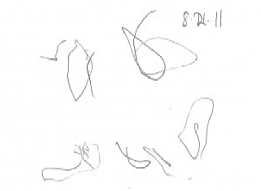
Writing Sample with Pencil, February 2011
Sam was asked to write his name at the top of the writing sample. You can see the “S” and the “a” at the beginning of Sam. However, I think all of us would agree that that outcome isn’t a good one after all of the input he had into writing his name over previous years.
In 2011 Sam was given daily opportunities to write and use his name for real reasons. He signed in every day. He wrote his name on every piece of work. He had to find his name on the work at the end of the day to take it home. He wrote his name to sign up for activities – and he had to find which activity he had signed up for later by locating his name. His teacher would put the workbooks on the table and Sam had to find his. Sam wrote his name with a pencil, a flip chart and on the computer. He never copied or traced it. But each time he had finished writing it a staff member would say, “Great Sam. Now let me show you how I would write your name,” and write it underneath. This continued until half way through the year when Sam was writing his name correctly all the time.
You can see Sam’s name in the sample below from November 2011. Most of the rest of his writing is still emergent – still letter-like shapes – but his name is definitely there. And so, his long-term goal was achieved by making sure that his name writing was always for real reasons.

Writing Sample with Pencil, November 2011
But name writing wasn’t the purpose of his balanced literacy instruction; it was just one of the many outcomes. Throughout 2011 Sam also did more extensive writing each day – and again each piece of writing was done for real reasons. Sam wrote about the book of the week, he wrote letters, he wrote about his personal experiences and opinions, and for many other purposes. On different days he used different writing tools. These varied between a pencil, a flip chart and a keyboard.

Writing with a Flip Chart, November 2011
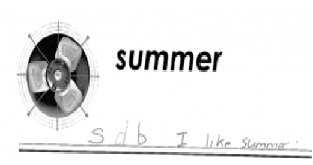
Writing Sample with a Flip Chart, November 2011
Daily literacy instruction didn’t just consist of writing, of course. Each day, Sam was involved in guided reading, i.e., reading for comprehension as part of a group. He did self-selected reading each day. He also did lots of activities focusing on consolidating his alphabet knowledge, improving his phonological awareness and helping him to read early sight words.
At the end of November 2011, Sam was still an emergent reader and writer. However, he had consolidated his emergent literacy understandings and was in a great position to move on to being a conventional reader and writer. Sam knew all of the letters of the alphabet, all of the time. He was starting to recognize some early sight words reliably. He had great knowledge of the concepts of print: he knew that it was text that carried the message in a book, he knew what one word looked like as opposed to two. His phonological awareness had improved enormously – he could tell you which words rhymed and which ones started with the same first sound – and he most definitely knew his name, how to write it and what he used it for. He understood the functions of text, including his name, and was in a good place to start developing the forms.
In 2012, Sam once again participated in balanced literacy instruction. The writing sample below from November 2012 shows that throughout the year Sam moved from being an emergent writer to being an early conventional writer. His writing is very phonetic – he has had a great go at spelling the words, writing down every letter that he hears.
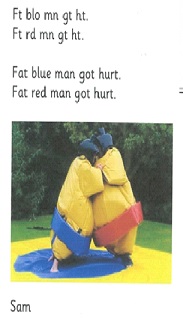
Writing Sample with a Keyboard, November 2012
A staff member followed up, saying “Great writing Sam. I love the letters you’ve used. Now let me show you how I would write it” – and then, after writing it, pointed out all the similar letters they have both used. This would have happened after every writing sample, providing great opportunities for teaching and learning.
Balanced literacy instruction continued through 2013, and of course is continuing this year. Last week when I visited Willans Hill again I was delighted to see how Sam’s writing has progressed. These days he mostly writes on a computer. It is much less physically effortful for him than writing with a pencil, which means he can put more cognitive energy into coming up with the language, the words and the spelling.
The photo below shows how absorbed he was in his writing – and the photo below that shows a close up of the screen.
Sam was writing a letter to another student at the school. It says, “Dear Luke, Have you got a football team? In the holidays I am going to…”
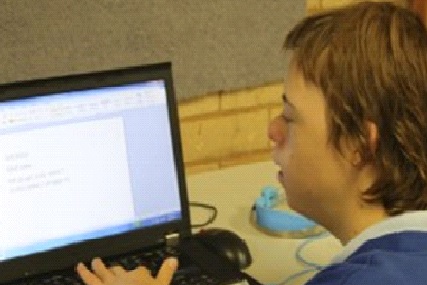
Sam Writing with a Keyboard, April 2014
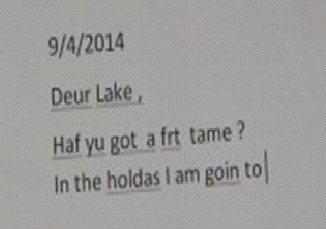
Writing Sample with a Keyboard, April 2014
Like many other students at Willans Hill School, Sam has progressed enormously in his literacy skills. Regular balanced literacy instruction has enabled him to develop as a reader and writer. Some students moved to being conventional readers and writers faster than Sam did, and others are taking longer. However, every student is developing their understandings of text and how it works and what we can do with it every day, which, of course, is the aim of good literacy instruction.
Willans Hill is one of a number of schools that I am privileged to work with on a regular basis. Each of these schools implements good literacy instruction daily in all classrooms for all students. Many of the students in these classrooms also have complex communication needs. Each school also understands the importance of communication in literacy development – and the provision of good, well-designed AAC systems and implementation is a priority.
And mostly importantly, we all believe strongly in the message in the quote from David Yoder (DJI-AbleNet Literacy Lecture, ISAAC 2000):
“No student is too anything to be able to read and write.”
Jane Farrall is a Consultant based in Australia. At ISAAC Conference 2014, Jane will be presenting a half-day Pre-conference Workshop, on July 19th, titled, “Speaking APPropriately: AAC andApps.” On July 20th, Jane Farrall and Sally Clendon will be co-presenting a full-day workshop, “’There is No Can’t’: AAC, Literacy and Meeting Complex Needs.” Register here for one or both workshops.